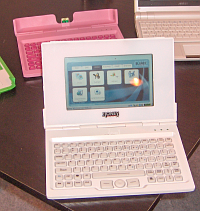Input Your Favorite Low-Cost ICT Device for Education Today!
Back when infoDev at the World Bank complied a Quick guide to low-cost computing devices and initiatives for the developing world, the educational community was a buzz about the promise of netbooks.
Now, several years on, how as the field changed? What new tools are available for teachers to improve their curriculum delivery? For students to master it? And for administrators to understand better the links, if any, between ICT investments and educational outcomes?
Please voice your opinion in the comments and add your favorite ICT device to our list, now an editable Google Doc:
Our goal is to have a comprehensive, up-to-date list by the end of this week for future publication on the infoDev website.
Do note that we do not expect this list to be exhaustive, it’s a Quick Guide after all, and we are purposely leaving off mobile phones, as well as the plethora of devices that could be used in education, for a more targeted list of hardware devices that are used in educational systems of the developing world.
We welcome your contribution to this endeavor in the comments or as your own Guest Post


The EduBook is a x86 based laptop designed for children. It uses rechargeable AA batteries which are easy to find and replace. It comes with a bright 8.9 inch screen. It doesn't need an external adapter and has no fan. The CPU is a 1Ghz Xore86 CPU that can run Windows or Linux. The list price is $199.95 with 8GB storage, 512 MB RAM, batteries and WIFI. At 10,000 units, the kit price is less than $150.00, making it the lowest cost laptop that can run Windows XP available for education. The EduBook is very modular and can be locally repaired.
OLPC can do all that for $100 even now. However,giving it the features of a tablet and dozens of other stuff adds to the cost twice as much. However, with the iPad like features and with Marvell technology, the cost will come down considerably and a version may be possible with all functions for about $150 in 2011. That will have a lot more for the children as they need a lot more than a miniature PC to work with and villages need the ruggedness and solar friendly attributes that add to the cost. But the movement is in the right direction.
Nobody that I have ever heard of has bought a OLPC unit for less than $188.00 in quantity of 10,000. the $100 price was widely publisized but was never achieved. The EduBook will run Windows XP or Linux while the OLPC only suports SugarOS (which also runs on the EduBook.
Many people like to say what can be manufactured and at what cost but they have no experience manufacturing. I do. Component costs have gone up and the trend of the US dollar against Asian currencies has been down. The cost of RAM, Flash and LCDs are all tracking upwards. PCBs are going up in price. Labor costs in China just went up 30%. People who believe that an iPad like device with anything other than a VIA 8505 CPU don't have a clue.
The Marvel CPU is a very good ARM CPU but what OS? Sure, you can run Android but what education software runs on Android? Touch screens are more expensive than keyboards and the trend for tablets will be to have costs go up — not down.
Sure, OLPC is saying they can do it for $100 — just like they said they would deliver a laptop for $100.00. I know the build of material costs for a Marvel based tablet. A 7.2 inch would cost aobut $120.00 — that is just he raw material. Larger screens will be more expensive. You can expect the cost of a 10.1 inch unit to be about $280 to $350 in very large quantties.